J. Cosmet. Sci., 70, 235–245 (September/October 2019) 235 Comparative Assessment of Biological Activities of Mistletoes for Cosmetic Applications: Viscum Album Var. Coloratum (Kom.) Ohwi and Loranthus Tanakae Franch. & Sav. SUNG-UP CHOI, SUNG TAE KIM, DONG GYUN HAN, YOUNG-HA HWANG, KOO YEON LEE, DONG UK KIM, KWAN HYUNG CHO, SANG YEOB PARK, HEE-CHEOL KIM, SEONG-BO KIM, and DONG-JIN JANG , Food and Pharmaceutical Science, Dongnam Health University, Suwon, 50834, South Korea (S.-U.C.), Department of Pharmaceutical Engineering, Inje University, Gimhae 50834, South Korea (S.T.K., D.G.H., Y.-H.H., D.U.K., D.-J.J.), Institute of Digital Anti-Aging Healthcare, Inje University, Gimhae 50834, South Korea (S.T.K., H.-C.K., D.-J.J.), Department of Bio-health Technology, Kangwon National University, Kangwon 24341, South Korea (K.Y.L.), Department of Pharmacy, Inje University, Gimhae 50834, South Korea (K.H.C.), Samyang Biopharmaceuticals Corporation, Seongnam 13488, South Korea (S.Y.P.), CJ CheilJedang, Life Ingredient & Material Research Institute, Suwon 16495, South Korea (S.-B.K.) Accepted for publication June 25, 2019 . Synopsis Mistletoes, hemiparasites, contain many components with various biological activities and have been used in cosmetics industry. Loranthacease (1,000 species) and Viscaceae (550 species) have the most dominant species in mistletoes (nearly 1,600 species). It can be expected that the biological activities vary from species to species therefore, we have tested Viscum album var. coloratum (Kom.) Ohwi (belonging to Santalaceae) and Loranthus tanakae Franch. & Sav. (belonging to Loranthacease) for a comparative study of their cosmetic properties, including antioxidant, antimelanogenic, and antiwrinkle activities. As results, the ethanol extract of L. tanakae had higher phenolic content and showed effective antioxidant activity and elastase inhibition. Meanwhile, the ethanol extract of V. album more effectively inhibited tyrosinase. Comparing with ethanol extracts, the water extracts of both mistletoes showed lower biological effi cacy than the ethanol extracts or no signifi cant effect. Thus, these results show that different extracts of mistletoe have different levels of biological activities, presumably because of the differences in their phytochemical profi les and because of the different extraction methods used. Address co-correspondence to Dong-Jin Jang at djjang@inje.ac.kr and Seong-Bo Kim at seongbo.kim@cj.net. Sung-Up Choi and Sung Tae Kim contributed equally to this work as co-fi rst authors.
JOURNAL OF COSMETIC SCIENCE 236 INTRODUCTION Mistletoes are semiparasitic plants that grow on deciduous trees, such as oak, pine, and elm. They have been widely used in traditional medicine in Asia, Africa, and Europe (1). Mistletoe extracts containing polyphenols, lectins (2), alkaloids (3), viscotoxins (4), and polysaccharides (5) have various biological properties, such as antioxidant (6), antitumor (7), antimicrobial (8), antiviral (9), and immunomodulatory activities (10,11). In addition to herbal medicines, mistletoes have been used in dietary supplements (12) and can be used as a cosmetic ingredient (13). Mistletoe extracts contain various phenolic derivatives such as phenolic acids and fl avonoids (14), which have been attractive ingredients for cosmetics (15). For example, Viscum album (CAS No. 84929-55-5 in EU) contains secondary metabolites with antioxidant properties (11). In practice, V. album (CAS No. 84929-55-5 in EU) has already been registered as a cosmetic ingredient in the Cosmetic Ingredient Database. In Korea, mistletoe is considered a potent biological ingredient. V. album has been studied and is listed in the Korean Cosmetic Ingredient Dictionary, which implies that there is a great degree of interest for cosmetic and cosmeceutical applications. Four species and four genera of the two families of mistletoe (Santalaceae and Lorantha- ceae) are distributed across the Korean Peninsula (16). The representative species of San- talaceae and Loranthaceae are V. album var. coloratum (Kom.) Ohwi (V. album) and Loranthus tanakae Franch. & Sav. (L. tanakae), respectively. The former is relatively well-studied than the latter regarding various aspects, as it is more widely distributed globally. Most stud- ies using Korean mistletoe V. album have evaluated its medicinal properties (17,18), al- though a few studies have focused on the biological, nutritional, and cosmeceutical aspects (19,20). The latter has rarely been studied, in spite of its effective biological activ- ity (21). To date, except for therapeutic approaches, mistletoes have been rarely studied despite their great potential in health and cosmetic industries. More importantly, thus far, there has been no comparative study among the different species of Korean mistletoes although their compositions are dependent on species. We aimed to investigate the potential effects of two different types of mistletoe extracts as a cosmetic/cosmeceutical ingredient through a comparative study of V. album belong- ing to Santalaceae and L. tanakae belonging to Loranthaceae because different species can have a vast range of biological effects. Our study can provide a rational basis, depending on the species and extraction methods, for biological as well as cosmetic applications. MATERIALS AND METHODS PREPARATION OF MISTLETOE EXTRACTS Both V. album and L. tanakae were provided by Prof. Kooyeon Lee from the Institute of Bioscience and Biotechnology, Kangwon National University. These mistletoes were au- thenticated by Prof. Yi Sung Shim and Dr. Bo Duk Lee, University of Seoul. In brief, V. album was collected from Jeongseon, Kangwon province, whereas L. tanakae was collected from Mt. Seorak, Kangwon province, South Korea. Both samples were dried naturally and extracted using double-distilled water (ddH2O) or ethanol (100% EtOH). 2-Diphenyl- 1-picrylhydrazyl (DPPH), mushroom tyrosinase, L -tyrosine, N-succinyl-Ala-Ala-Ala-p- nitroanilide, porcine pancreatic elastase (PPE), potassium ferricyanide, trichloroacetic
Purchased for the exclusive use of nofirst nolast (unknown) From: SCC Media Library & Resource Center (library.scconline.org)


















































